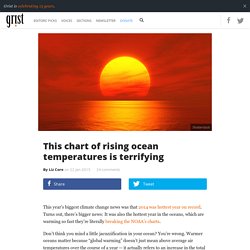

This chart of rising ocean temperatures is terrifying. This year’s biggest climate change news was that 2014 was hottest year on record.

Turns out, there’s bigger news: It was also the hottest year in the oceans, which are warming so fast they’re literally breaking the NOAA’s charts. Don’t think you mind a little jacuzzification in your ocean? You’re wrong. Warmer oceans matter because “global warming” doesn’t just mean above average air temperatures over the course of a year — it actually refers to an increase in the total amount of heat energy contained in the Earth’s systems. While air temperatures can fluctuate on any given year, they are usually matched by an increase or decrease of the amount of heat stored in the oceans (which, by the way, absorb around 90 percent of total global warming heat). Luckily, NOAA has been tracking ocean energy data for decades, updating its charts every few months. OK, people. These are dark days for the Arctic — literally. Things are getting gloomy up north, where the Arctic region is losing its albedo.

No, not libido — this isn’t a problem that can be fixed with ice-blue pills and adventurous nature videos. Albedo. There’s no “warming pause” — trade winds are burying heat in the Pacific. Global average land temperatures have not increased as quickly as many scientists had expected over the past 10 or 15 years, leading some climate skeptics to latch onto the bogus idea of a “global warming pause.”

Last year researchers reported that much of the “missing heat” was not in fact missing but rather was being sucked up by the oceans. Now new research helps explain why excess heat is being absorbed into the sea: big-ass winds. A paper published in the journal Nature Climate Change suggests that the slowdown in surface warming and the acceleration in ocean warming has been largely driven by a phase in a natural ocean cycle called the Interdecadal Pacific Oscillation (IPO). That’s a frightfully cumbersome name, but it’s easy to break down: It’s a swing (“oscillation”) in Pacific Ocean weather that takes decades (“interdecadal”) to shift from one phase to another.
And that has helped bury extra heat at sea — for now. Global ocean heat and salt content. Your computer is JavaScript disabled.

Oceans are absorbing excess heat, for now. Pity the oceans.

Not only do we dump oil and plastics and all kinds of nasty chemicals and garbage into them. Turns out we’re dumping heat into them too. Atlantic coastal waters are the hottest since measurements began. Would you like some broiled flounder with your serving of climate apocalypse?

Well, you’re going to have to broil it yourself, because record-breaking temperatures in the Atlantic Ocean are driving the fish away from fast-heating waters toward more hospitable depths and latitudes. The Atlantic Ocean’s surface temperatures from Maine to North Carolina broke records last year, reaching an average of 57.2°F, nearly three degrees warmer than the average of the past 30 years. The Pacific Ocean is now warming 15 times faster than it used to.
It’s conservatives’ favorite science-denying talking point: that global warming has slowed down, or even stopped altogether, over the last 15 years.

It’s bogus, of course. Read Chris Mooney’s great feature for a full breakdown of how the myth has been spread. (Among other dishonest shenanigans, conservatives are using 1998 as their baseline because it was an unusually warm year due to El Niño.) But there is a grain of truth to it: Average global surface-air temperatures have been rising at a slower rate than some climate scientists projected.
A reason, as a new study published in Science on Thursday helps demonstrate, is that the oceans have been absorbing much of the heat. Ocean temperatures spiked in 2013. Perhaps climate skeptics should be forced to walk the plank — so they can feel for themselves where so much of the globe’s extra heat is ending up.

The mainstream media repeatedly uttered the false but reassuring-sounding phrase “global warming pause” last year, a reference to an unexpected decline in the rate at which land temperatures have been recently warming, but meanwhile temperatures in the world’s oceans were spiking. Just check out this graph from NOAA, which shows the rise in the amount of energy in the top 2,300 feet (700 meters) of the world’s oceans: Skeptical Science puts the chart into some context: Long-term the oceans have been gaining heat at a rate equivalent to about 2 Hiroshima bombs per second, although this has increased over the last 16 or so years to around 4 per second. In 2013 ocean warming rapidly escalated, rising to a rate in excess of 12 Hiroshima bombs per second — over three times the recent trend.
Nature can, selectively, buffer human-caused global warming, say scientists. Can naturally occurring processes selectively buffer the full brunt of global warming caused by greenhouse gas emissions resulting from human activities?

Yes, find researchers from the Hebrew University of Jerusalem, Johns Hopkins University in the US and NASA's Goddard Space Flight Center. As the globe warms, ocean temperatures rise, leading to increased water vapor escaping into the atmosphere. Water vapor is the most important greenhouse gas, and its impact on climate is amplified in the stratosphere.